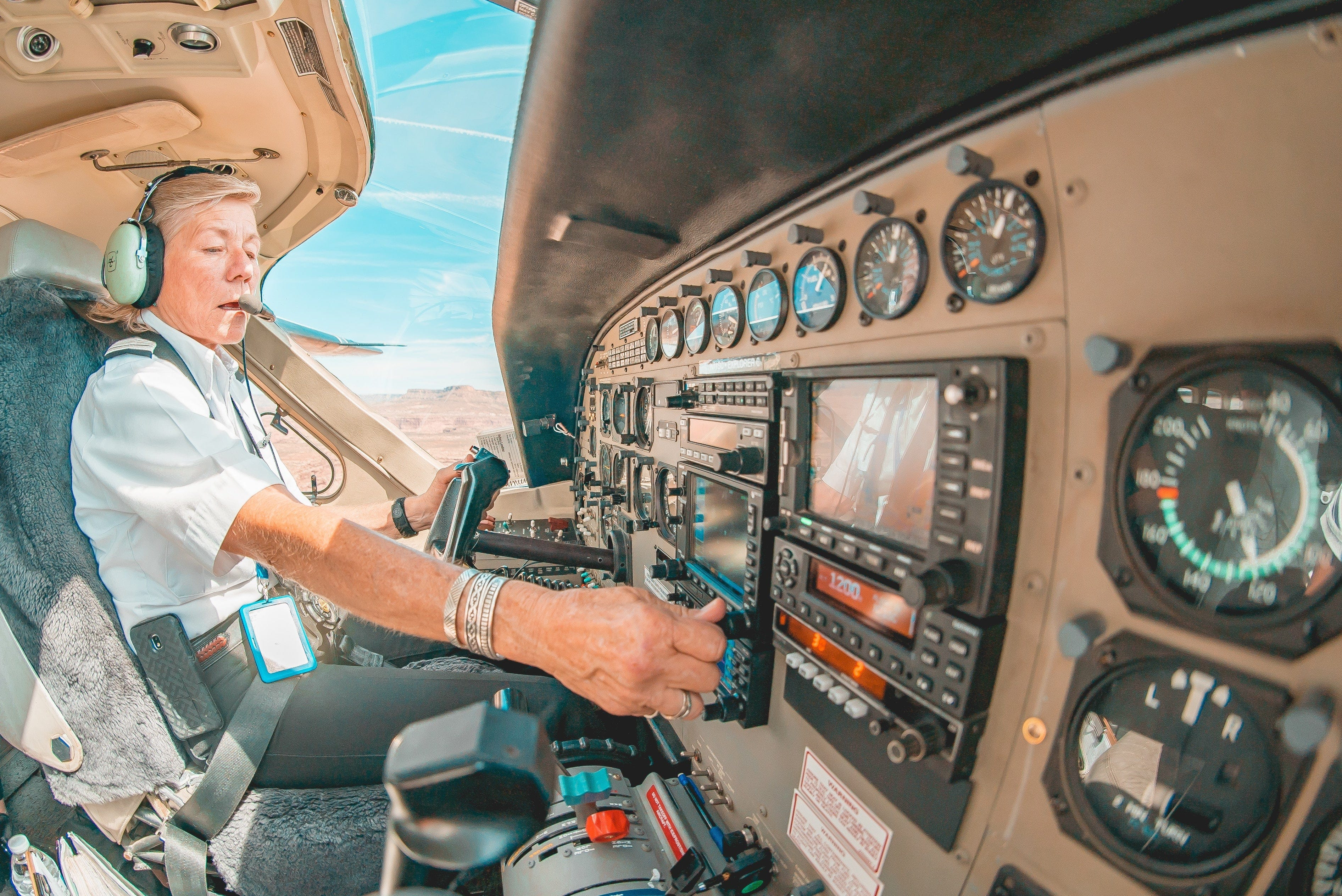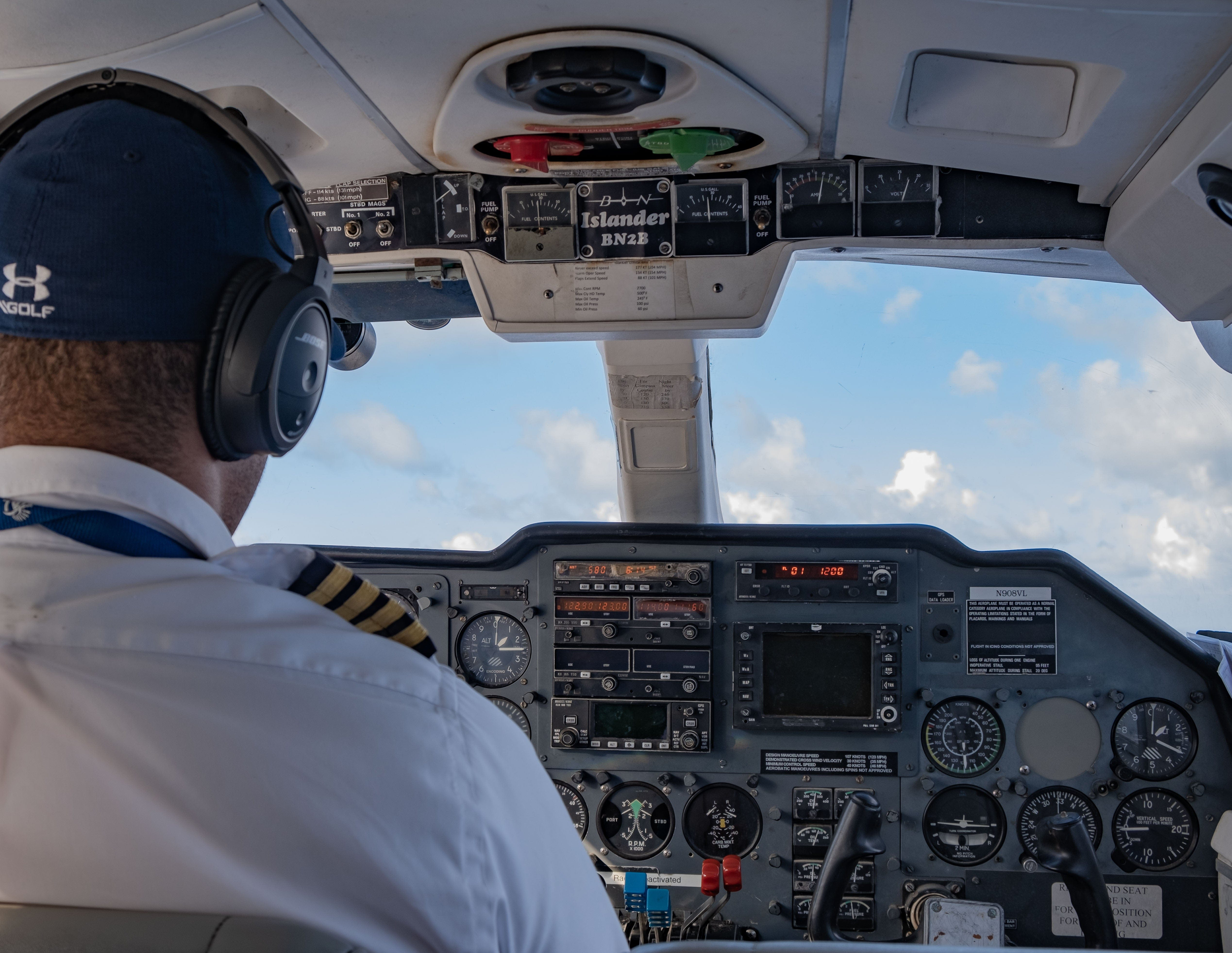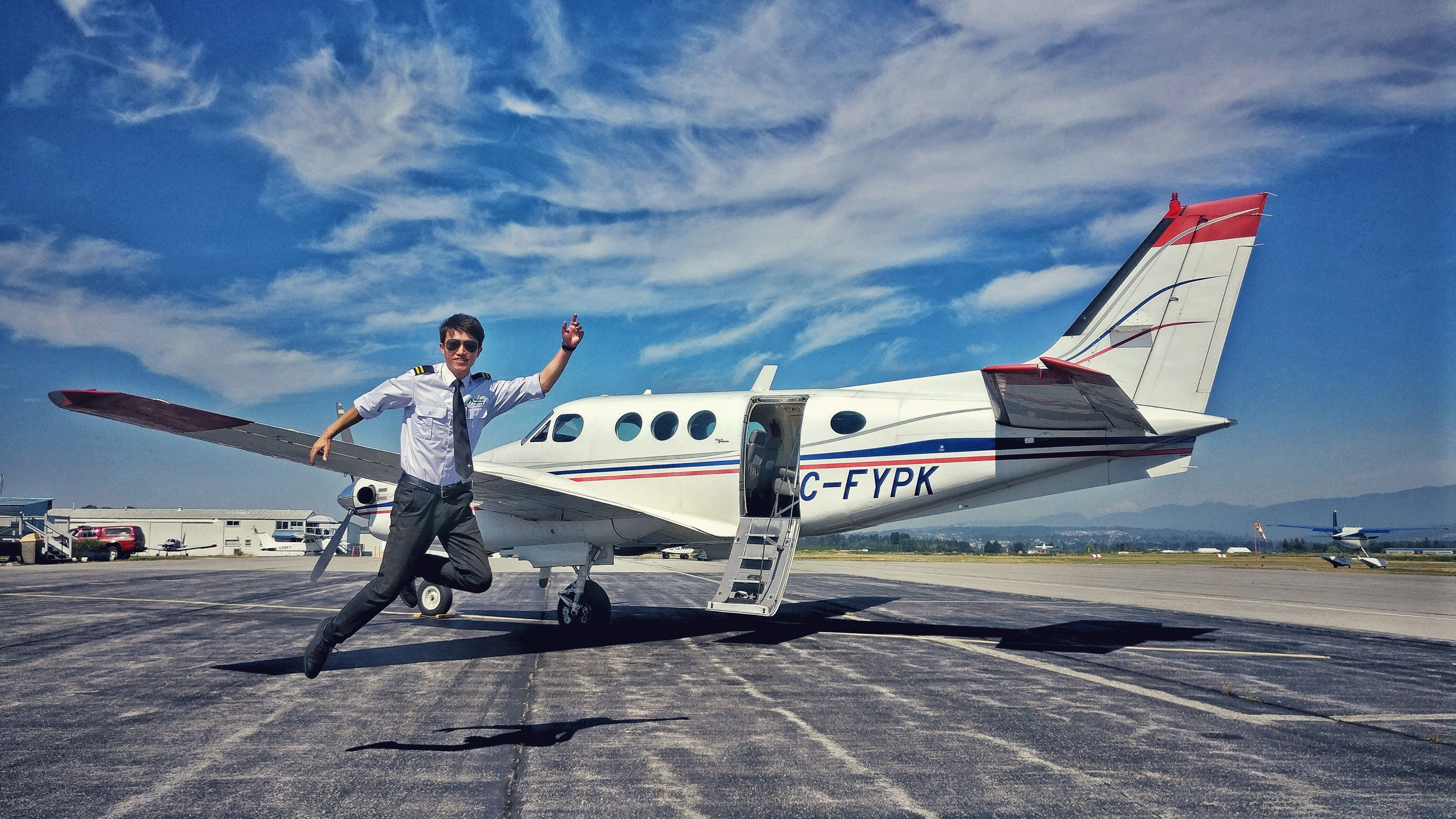How Many Hours Can A Pilot Fly In A Month? If you’re considering a career as a pilot, understanding flight time limitations is crucial, and Flyermedia.net is here to provide clarity. The regulations set forth by aviation authorities and airlines directly impact pilot schedules, influencing their work-life balance and overall career satisfaction. Knowing these limits helps aspiring pilots make informed decisions about their aviation careers.
1. What Does a Pilot’s Day Look Like?
The life of a pilot is anything but monotonous. Each day brings new destinations and experiences, setting it apart from routine jobs. Pilots often navigate diverse time zones, flying to various cities and countries. Some pilots focus on numerous shorter flights within a day, while others handle fewer but longer flights that involve layovers.
1.1. A Typical Day
Pilots begin their day by checking in with their airline at the airport, then proceeding through security to their assigned gate with their flight bag. Once on board, the pilot will meet with co-pilots and flight crew. They then get to work conducting final pre-flight planning, working through their pre-flight checklists and ultimately getting underway once receiving clearance to push back from the gate.
 A pilot walking with their flight bag through an airport, showcasing a typical scene in their day
A pilot walking with their flight bag through an airport, showcasing a typical scene in their day
After landing at their destination, a pilot might be done flying for the day, or they might have another flight soon. Pilots doing quick turnarounds or short hops might be back in the air in as little as thirty minutes. Following longer flights, pilots usually get at least 8-10 hours of rest at a hotel before returning to the airport.
2. How Many Hours Can a Pilot Fly in a Month?
On average, airline pilots fly around 75 hours each month, though the legal limit is 100 hours. Officially, flight time counts from when the aircraft powers up until it shuts down at the destination. According to the U.S. Bureau of Labor Statistics, pilots also spend about 150 hours a month on the ground doing flight planning, checking weather, and other tasks. This totals about 225 hours of work per month.
Flying Mag estimates similar numbers, noting that commercial pilots average 85 flight hours and 80 ground hours monthly. Pilots operating under Part 135 regulations can fly up to 120 hours a month.
 A pilot in the cockpit, meticulously reviewing flight plans and preparing for takeoff
A pilot in the cockpit, meticulously reviewing flight plans and preparing for takeoff
3. How Long Are Pilots’ Shifts?
A pilot’s shift includes both flight time and other duties, with the FAA setting limits for each. Single pilots can have shifts between 9 and 14 hours, while flights with two or more pilots can extend shifts to 13 to 19 hours. Actual flight time can range from eight to 17 hours, depending on the start time and the number of pilots. Non-flight duties like weather checks and planning add to the total time commitment.
4. How Many Hours a Day Do Pilots Work?
Pilots can work up to 19 hours a day, including flight time, but regulations mandate at least 8 to 10 hours of rest between shifts. This ensures they don’t consistently work extremely long days. Additionally, pilots must adhere to the rule that they can’t fly more than 30 hours in seven consecutive days, preventing continuous extended duty shifts.
5. How Many Hours Can Pilots Fly in a Year?
FAA regulations limit Part 121 pilots to 1,000 flight hours per year, aiming to reduce fatigue. Most pilots fly around 900 hours annually, according to the Bureau of Labor Statistics. Part 135 commercial pilots have a slightly higher cap of 1,200 hours per year.
5.1. Staying Organized
Pilots use digital and physical logbooks to keep track of their hours. A backup physical logbook can be a great way to stay organised.
6. Do Pilots Get Weekends Off?
Pilots often work on weekends and holidays, especially early in their careers when they have less seniority. Flight assignments are based on seniority, so pilots with more experience can often choose their preferred days off, giving them more control over their schedules.
7. How Are Pilots’ Schedules Assigned?
Airlines typically use a seniority-based system where pilots bid on flight schedules or “lines.” The airline creates a list of numbered schedules, and pilots rank these schedules according to their preferences. Seniority determines the order in which pilots get their choices. The pilot with the highest seniority gets their top choice, and so on down the list.
7.1. Reserve Pilots
Newer pilots may find themselves on “reserve,” meaning they don’t have a fixed schedule and are called in to cover shifts as needed. This can be due to weather, mechanical issues, or other pilots calling in sick. While being a reserve pilot can be challenging for work-life balance, it’s often a necessary step to gain seniority and secure a more predictable schedule.
8. How Often Are Pilots Home?
How often a pilot is home depends on the type of job they have. Regional airlines with frequent “out and back” flights allow pilots to be home most nights. Long-haul pilots might be away for three to four days at a time, followed by a few days off. Long-haul pilots generally have longer shifts but get more extended breaks, while short-haul pilots may be home nightly but have fewer days off.
8.1. Variables
Corporate and charter pilots often work a 7-day on, 7-day off schedule. According to Kelsey from the YouTube channel 74 Gear, airline pilots average 15 or 16 days of flying per month, usually in three- or four-day trips followed by several days off. Some airlines allow pilots to trade flights, offering more flexibility. Living in a base city for your airline can also increase time at home, eliminating commute time after flights.
 A pilot enjoying a moment of relaxation at home, emphasizing the importance of downtime between flights
A pilot enjoying a moment of relaxation at home, emphasizing the importance of downtime between flights
9. Do Pilots Have Time for Family?
Balancing a pilot career with family life requires communication, realistic expectations, flexibility, and patience. Junior pilots average about twelve days off a month, while senior pilots can have up to twenty days off. On average, pilots get about fifteen days off each month.
9.1. Travel Benefits
One significant perk is access to free or reduced-fare air travel for pilots and their families, allowing them to enjoy amazing travel adventures during their time off.
 A pilot enjoying time with family during vacation, highlighting the benefits of travel perks in the aviation industry
A pilot enjoying time with family during vacation, highlighting the benefits of travel perks in the aviation industry
10. What Is the Pilot Retirement Age?
The FAA mandates that airline pilots retire by age 65. However, some pilots may need to retire earlier if they develop a disqualifying condition that prevents them from maintaining their FAA medical certificate.
11. How Much Do Pilots Make per Hour?
Pilot pay varies widely based on education, certification, experience, seniority, and the airline they work for. As of 2023, salary.com estimates that airline pilots earn between $71 and $108 per hour, with a median hourly pay of $88.
12. How Much Do Pilots Make a Year?
According to the U.S. Bureau of Labor Statistics, the median annual salary for airline and commercial pilots was $134,630 as of 2021. For “airline pilots, copilots, and flight engineers,” the median salary was $202,180.
The lowest 10% of pilots earned less than $50,080, while the highest 10% earned more than $208,000. The industry outlook is positive, with a projected growth of 13% between 2020 and 2030.
13. What are the Factors Influencing Pilot Flight Hour Limits?
Pilot flight hour limits are not arbitrary numbers. They are carefully calculated based on extensive research and consideration of several crucial factors. These factors are designed to ensure the safety and well-being of both pilots and passengers.
13.1. Fatigue Management
One of the primary concerns in aviation is pilot fatigue. Extended periods of flying can lead to decreased alertness, impaired decision-making, and slower reaction times. These impairments can significantly increase the risk of accidents. According to research from Embry-Riddle Aeronautical University, in July 2025, fatigue is a contributing factor in approximately 15-20% of aviation accidents. Flight hour limits are designed to mitigate fatigue by ensuring pilots have sufficient rest periods between flights and over longer durations.
13.2. Regulatory Compliance
Aviation regulations, such as those set by the FAA in the United States and EASA in Europe, dictate the maximum flight hours allowed for pilots. These regulations are based on scientific studies and industry best practices to prevent pilot fatigue and maintain safety standards. Compliance with these regulations is not only mandatory but also essential for maintaining the integrity and safety of air travel.
13.3. Operational Demands
The type of flying a pilot does also influences flight hour limits. For example, long-haul international flights may have different regulations compared to short-haul regional flights. Factors such as time zone changes, night flying, and the intensity of flight operations all play a role in determining appropriate flight hour limits.
13.4. Crew Composition
The number of pilots in a flight crew can affect flight hour limits. Flights with two or more pilots may have different rules compared to single-pilot operations. This is because having multiple pilots allows for shared workload and the opportunity for in-flight rest, reducing the risk of fatigue.
14. Understanding FAA Regulations on Pilot Flight Hours
The Federal Aviation Administration (FAA) sets specific regulations on pilot flight hours to ensure safety and prevent pilot fatigue. These regulations vary depending on the type of operation, such as Part 121 (scheduled airlines) and Part 135 (charter and commuter operations).
14.1. Part 121 Operations
For pilots operating under Part 121, which includes most major airlines, the FAA has strict limits on flight hours and duty periods. These limits include:
- Maximum Flight Hours: A pilot cannot exceed 100 flight hours in any calendar month or 1,000 flight hours in any calendar year.
- Duty Period Limits: The maximum duty period (the time from when a pilot reports for duty until they are released) varies depending on the time of day and the number of flight segments. For example, a duty period starting in the daytime may be longer than one starting at night.
- Rest Requirements: Pilots must have a minimum of 10 hours of rest between duty periods, including at least 8 hours of uninterrupted sleep.
- Fatigue Risk Management Systems (FRMS): Airlines are required to implement FRMS to monitor and mitigate pilot fatigue. These systems use data analysis and reporting to identify and address potential fatigue-related issues.
14.2. Part 135 Operations
Part 135 regulations cover charter and commuter operations, which have different flight hour limits compared to Part 121. These limits include:
- Maximum Flight Hours: A pilot cannot exceed 1,200 flight hours in any calendar year or 34 hours in any seven consecutive days.
- Duty Period Limits: The maximum duty period is typically shorter than under Part 121, reflecting the different nature of these operations.
- Rest Requirements: Similar to Part 121, pilots must have a minimum of 10 hours of rest between duty periods, including at least 8 hours of uninterrupted sleep.
14.3. Additional Considerations
- Cumulative Fatigue: The FAA also considers cumulative fatigue, which is the buildup of fatigue over time. Regulations address this by limiting the number of consecutive days a pilot can be on duty and requiring longer rest periods after extended operations.
- Medical Certificates: Pilots must maintain a valid medical certificate to ensure they are fit for duty. Medical conditions and medications can affect a pilot’s ability to fly safely, and the FAA has guidelines for managing these issues.
15. What is the Impact of Flight Hour Regulations on Pilot Work-Life Balance?
While flight hour regulations are crucial for safety, they also have a significant impact on a pilot’s work-life balance. Understanding these impacts can help aspiring pilots make informed decisions about their careers.
15.1. Predictability of Schedules
One of the main challenges for pilots is the unpredictable nature of their schedules. Flight hour limits and duty period restrictions can lead to irregular work hours and frequent changes in schedules. This can make it difficult to plan personal and family activities.
15.2. Time Away From Home
Pilots often spend extended periods away from home, particularly those working for major airlines or on long-haul routes. Flight hour regulations contribute to this by limiting the number of consecutive days a pilot can work, which can result in longer trips and more time spent in hotels.
15.3. Fatigue and Stress
Despite the regulations aimed at preventing fatigue, pilots can still experience high levels of stress and fatigue due to the demands of their job. Irregular schedules, time zone changes, and the responsibility of ensuring passenger safety can all take a toll. Effective fatigue management strategies, such as regular exercise, healthy eating, and sufficient sleep, are essential for maintaining well-being.
15.4. Social and Family Life
The demands of a pilot’s career can strain social and family relationships. Frequent absences and unpredictable schedules can make it difficult to maintain close connections with loved ones. However, many pilots find ways to balance their work and personal lives through effective communication, careful planning, and making the most of their time off.
15.5. Career Progression
Flight hour regulations can also affect a pilot’s career progression. Building flight hours is essential for advancing from regional airlines to major carriers, and the limits on flight hours can slow down this process. However, the regulations also ensure that pilots gain experience safely and responsibly.
16. How do Airlines Manage Pilot Schedules to Comply with Regulations?
Airlines employ sophisticated scheduling systems to manage pilot schedules and ensure compliance with flight hour regulations. These systems take into account various factors, such as flight routes, crew availability, rest requirements, and operational needs.
16.1. Advanced Scheduling Software
Airlines use advanced scheduling software to optimize pilot schedules and minimize the risk of fatigue. These systems automatically track flight hours, duty periods, and rest requirements, alerting schedulers to potential violations.
16.2. Crew Resource Management (CRM)
CRM training teaches pilots and other crew members how to work together effectively to manage fatigue and make safe decisions. This includes strategies for communicating fatigue-related concerns and supporting each other during long flights.
16.3. Fatigue Risk Management Systems (FRMS)
As mentioned earlier, FRMS are used to monitor and mitigate pilot fatigue. These systems collect data on flight hours, sleep patterns, and other factors to identify and address potential fatigue-related issues.
16.4. Reserve Crews
Airlines maintain reserve crews to cover unexpected absences or schedule changes. Reserve pilots are available to fill in when scheduled pilots are unable to fly due to illness, fatigue, or other reasons.
16.5. Open Communication
Open communication between pilots and airline management is essential for managing pilot schedules effectively. Pilots need to feel comfortable reporting fatigue-related concerns without fear of reprisal, and airlines need to be responsive to these concerns.
17. What are the Latest Updates and Changes in Pilot Flight Hour Regulations?
Pilot flight hour regulations are not static; they are continually reviewed and updated based on new research and industry best practices. Staying informed about the latest updates and changes is crucial for pilots and aviation professionals.
17.1. Recent FAA Updates
The FAA regularly updates its regulations to address emerging safety concerns and incorporate new technologies. Recent updates have focused on areas such as fatigue risk management, electronic flight bags (EFBs), and the use of unmanned aircraft systems (UAS).
17.2. International Regulations
International aviation organizations, such as the International Civil Aviation Organization (ICAO), also issue guidelines and recommendations on pilot flight hours and fatigue management. These guidelines are often adopted by individual countries and incorporated into their national regulations.
17.3. Industry Initiatives
Airlines and pilot unions also work together to develop and implement best practices for managing pilot fatigue and ensuring compliance with flight hour regulations. These initiatives often involve innovative approaches to scheduling, training, and technology.
18. Resources and Tools for Pilots to Manage Flight Hours Effectively
Pilots have access to a variety of resources and tools to help them manage their flight hours effectively and ensure compliance with regulations. These resources include:
18.1. Electronic Logbooks
Electronic logbooks allow pilots to track their flight hours, duty periods, and rest requirements in real-time. These tools can automatically calculate cumulative flight hours and alert pilots to potential violations.
18.2. Fatigue Monitoring Apps
Fatigue monitoring apps use data on sleep patterns, flight hours, and other factors to assess a pilot’s fatigue level. These apps can provide personalized recommendations for managing fatigue and improving sleep quality.
18.3. Aviation Safety Reporting System (ASRS)
The ASRS is a confidential reporting system that allows pilots and other aviation professionals to report safety-related concerns without fear of reprisal. This system provides valuable data for identifying and addressing potential safety issues.
18.4. Pilot Associations and Unions
Pilot associations and unions offer a variety of resources and support services for pilots, including guidance on flight hour regulations, fatigue management, and career development.
19. The Future of Pilot Flight Hour Regulations: What to Expect?
The future of pilot flight hour regulations is likely to be shaped by several factors, including technological advancements, new research on fatigue, and evolving industry practices.
19.1. Advanced Fatigue Modeling
Advanced fatigue modeling techniques are being developed to more accurately predict the effects of fatigue on pilot performance. These models take into account individual differences in sleep patterns, workload, and other factors.
19.2. Automation and Artificial Intelligence (AI)
Automation and AI technologies are being used to optimize pilot schedules and reduce the risk of fatigue. These technologies can automatically adjust schedules based on real-time data and provide personalized recommendations for managing fatigue.
19.3. Focus on Wellness
There is a growing emphasis on pilot wellness, with airlines and pilot unions implementing programs to promote physical and mental health. These programs include access to counseling services, fitness facilities, and stress management training.
19.4. Data-Driven Decision Making
Data-driven decision making is becoming increasingly important in aviation, with airlines using data on flight hours, sleep patterns, and other factors to make informed decisions about pilot scheduling and fatigue management.
20. How to Find More Information About Pilot Careers and Flight Hour Regulations?
If you’re interested in learning more about pilot careers and flight hour regulations, there are several resources available to you. Flyermedia.net can provide you with a lot of useful information.
20.1. Aviation Authorities
The FAA and other aviation authorities provide detailed information on pilot regulations, training requirements, and career opportunities.
20.2. Aviation Schools and Universities
Aviation schools and universities offer a variety of programs for aspiring pilots, including flight training, aviation management, and aviation safety.
20.3. Pilot Associations and Unions
Pilot associations and unions provide valuable resources and support services for pilots, including guidance on flight hour regulations, career development, and industry news.
20.4. Online Forums and Communities
Online forums and communities offer a place for pilots and aviation enthusiasts to connect, share information, and ask questions about pilot careers and flight hour regulations.
Understanding the limitations on how many hours a pilot can fly in a month is essential for those considering a career in aviation. It is also important to the safety of passengers. These regulations are designed to prevent fatigue and ensure that pilots are well-rested and alert while operating aircraft. If you’re interested in learning more about flight training, aviation news, and career opportunities, visit Flyermedia.net today.
Address: 600 S Clyde Morris Blvd, Daytona Beach, FL 32114, United States
Phone: +1 (386) 226-6000
Website: Flyermedia.net
Frequently Asked Questions (FAQs)
-
What is the maximum number of flight hours a pilot can accumulate in a month?
The regulations limit Part 121 pilots to 100 flight hours per calendar month and 30 hours in any seven consecutive days. -
How many hours of rest are pilots required to have between shifts?
Regulations usually require at least an 8- to 10-hour rest break in between shifts. -
Do flight hour regulations differ between Part 121 and Part 135 operations?
Yes, flight hour regulations vary depending on the type of operation, such as Part 121 (scheduled airlines) and Part 135 (charter and commuter operations). -
How does seniority affect a pilot’s schedule and time off?
Flight assignments are seniority-based, so later in your career, you should have more schedule flexibility to choose your preferred days off. -
What is a reserve pilot, and how does it impact their schedule?
A reserve pilot is a backup who doesn’t have a set schedule and instead is called at a moment’s notice to fill shifts that need to be filled urgently due to any number of factors, including weather/mechanical delays or scheduled pilots calling in sick. -
How do airlines ensure compliance with pilot flight hour regulations?
Airlines employ sophisticated scheduling systems to manage pilot schedules and ensure compliance with flight hour regulations. These systems take into account various factors, such as flight routes, crew availability, rest requirements, and operational needs. -
What is the retirement age for pilots, according to the FAA?
The FAA currently requires all airline pilots to retire by age 65. -
How much do pilots typically earn per year?
According to the U.S. Bureau of Labor Statistics, as of 2021, the median commercial and airline pilot’s salary was $134,630 per year. If you narrow it down to just “airline pilots, copilots, and flight engineers,” the median bumps up to $202,180. -
What factors can affect a pilot’s flight hour limits?
Pilot flight hour limits are not arbitrary numbers. They are carefully calculated based on extensive research and consideration of several crucial factors, such as fatigue management, regulatory compliance, operational demands and crew composition. -
Where can I find more information about pilot careers and flight hour regulations?
If you’re interested in learning more about pilot careers and flight hour regulations, there are several resources available to you, such as the FAA, aviation schools and universities and online forums and communities. flyermedia.net can also provide you with a lot of useful information.